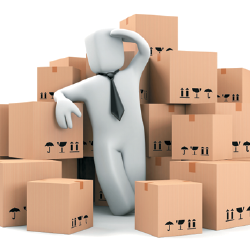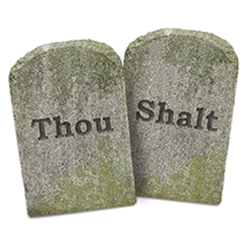 |
 Candy Adams,
Candy Adams,
CTSM, CME,
CEM, CMP, CMM,
"The Booth Mom,"
is an independent exhibit-management
consultant, trainer, speaker, writer, and an Exhibitor conference
faculty member.
CandyAdams
@BoothMom.com |
| |
 t almost every trade show, exhibitors give away countless promotional items in hopes of influencing attendees' decisions to buy their products and services. Whether you call them promotional items, premiums, adcentives (advertising incentives), tchotchkes, or swag, exhibitors distribute pens, hats, T-shirts, and coffee mugs by the box full, hoping to get a return on their investment. But do they actually see any sort of ROI? t almost every trade show, exhibitors give away countless promotional items in hopes of influencing attendees' decisions to buy their products and services. Whether you call them promotional items, premiums, adcentives (advertising incentives), tchotchkes, or swag, exhibitors distribute pens, hats, T-shirts, and coffee mugs by the box full, hoping to get a return on their investment. But do they actually see any sort of ROI?
The answer depends on how effectively they use them. Giveaways can attract your target market to your exhibit, especially if you mention them in pre-show mailings. And once your prospects are in your exhibit, promotional items can be used to generate leads that can be converted to sales, and act as a thank you for attendees' time and participation. A themed tchotchke that supports your integrated marketing message can help attendees tie that message back to your company after the show. And the continued use of the item you've distributed can promote memorability long after attendees return home.
But giveaways can also be a waste of money. To help you avoid blowing your budget on ineffective adcentives, here are 12 common giveaway blunders and tips on how you can sidestep your way to more successful strategies.
1. Choosing your giveaway before setting objectives. Your exhibit theme or message should be supported by your premium, not driven by it. Set your goals and objectives first. Then, if appropriate, choose a premium to meet a specific goal, such as conveying a specific message about your company's product or service, reinforcing a recent ad campaign, introducing your latest product offering, or reminding attendees about your exhibit's theme and message. For example, if your company's objective at the show is to increase awareness, you might want to consider a unique-but-low-cost item that will generate buzz. However, if your goal is simply to connect with a handful of VIPs, consider a more expensive, higher-quality item than an oh-so-typical branded pen or T-shirt.
2. Misunderstanding your target audience. When choosing a promotional item, make sure it will attract your target market, based on their demographics and psychographics. Try to pick items that your prospects would keep on top of their desks - think "top of desk, top of mind." Will they look at it, handle it, play with it, or use it often? What items have you kept from the shows you have attended, and why? To help you select an appropriate item, consult your sales department. Salespeople work directly with your target audience and likely have insight into what they might like and dislike. Also consider asking some of your current clients what sorts of things they'd appreciate, and see if you can find any common interests to drive your purchasing decision.
3. Selecting giveaways in a vacuum. Use the collective brainpower of your staff and adcentive vendor to come up with message-supporting ideas for your exhibit theme and relevant giveaways. Call a meeting with your creative-department colleagues to brainstorm theme ideas. Scan the Internet for promotional items or vendor catalogs to look for new items. After coming up with some possible themes, share your requirements with your vendor. It can provide pre-, at-, and post-show tie-ins to reinforce your marketing message.
Asking for input from customers, vendors, or co-workers can also help you avoid embarrassing mistakes. For example, one of my clients thought holographic, logoed mouse pads would be a great giveaway. Had she consulted anyone in the tech department at the computer company she worked for, she would have realized that the reflective surface of the mouse pad refracts the light given off by the optical mice that most people now use (as opposed to roller-ball mice), so it was unusable. She ended up with boxes of leftovers after the show.
4. Giving the same gift to all levels of customers or prospects. Take into consideration the value of the business you may get from your customers and prospects, and tier your giveaways accordingly. The swag you give to the "drive-by" prospect who quickly scans your information counter for trinkets shouldn't be the same as the gift for your long-term customers or highly qualified prospects. One of my clients gives out branded coffee-shop gift cards to both prospects and customers but distributes the various denominations - usually $5 and $20 - based on the value of past and future business. Another client, with the theme "Isn't it time," gave away $1 stopwatches to casual visitors and $12 desk clocks to qualified customers and prospects.
5. Giving away "no-no" items. Read your exhibitor service guide's rules and regulations to find out if show management has prohibited any giveaways. Prohibited items often include what are considered "nuisance" items that are hard to clean up, such as stickers or gum that show management has to pay to have scraped up after the show is over; helium balloons that could get loose and end up on the convention-hall ceiling; or messy food such as popcorn that ends up all over the show carpet. Some shows even ban all giveaway items unless they are part of a show sponsorship, hoping to glean more sponsorship dollars from exhibitors. If you do give away prohibited items, you might be charged cleanup costs or have your items confiscated until after the show.
6. Not considering the total cost of your giveaways. Don't forget to compute the real cost of your giveaways in addition to the per-item cost. That includes setup costs; printing costs, which can vary depending on the number of colors you want to print and the size of the imprint; shipping to your company; shipping to the trade show based on weight or volume; and material handling and storage costs at the show. It all adds up.
Also remember to figure bulk discounts into your total costs. You can save a bundle when you buy your giveaways in quantity. Determine how many of the shows on your calendar will have a similar target audience where you can use the same key message, exhibit theme, and giveaways. Ask your vendor what the price breaks are for various quantities.
7. Distributing low-quality items. Strive to find tchotchkes with a high perceived value for their cost. I've received pens that leak or don't write, yo-yos that fall apart, and flashlights that won't light up. Even though these products aren't manufactured by the company giving them away, it's still a poor reflection on that company - not to mention the fact that if your attendees throw your giveaways in the garbage, you could just as easily avoid the middle man and toss the money you spent on them in the trash yourself.
8. Winning the Tacky and Tasteless Award. I've been offered chocolate-covered insects, condoms, T-shirts, and boxer shorts with tasteless double entendres as show giveaways. If you're trying to create a buzz among attendees with your giveaway, make sure it is a positive buzz. Ask yourself: Is this the image my company wants attendees to remember us by? There's a time and place for edgy promotional items, but make sure you're ready for any fallout should you choose to distribute potentially controversial swag.
9. Omitting your message or logo. Believe it or not, some companies give away promotional items at trade shows with nothing printed on them to identify which company handed them out. Others imprint them with the company logo, tag line, or URL in an itty-bitty, unreadable font. Identify the best way for attendees to get in touch with your company and print that information on your giveaways. Make sure this contact method will work for all attendees. One of my clients printed an 800 number on a promotional item for an international trade show, but the 800 number didn't work when dialed from that country. Bottom line, if your giveaways don't include your company name and contact information, they might as well have come from your competition.
10. Creating an unrelated contest. One of my pet peeves is the "passport" contest where attendees have to get a card stamped or stickered by a number of exhibitors to enter a drawing or contest. I've found these to be a total waste of time and exhibit-staff resources. The majority of these people are not prospects, but contestants - aka "swag stalkers." As a general rule, serious show attendees don't want to spend more than a few minutes filling out puzzles, tests, or surveys. Be realistic about the amount of time it will take attendees to earn your item, and ask yourself whether your target audience will take the bait and participate.
11. Piling your giveaways on your reception desk. Just laying your company's giveaways out on the counter for any passing booth beggar devalues them. It also limits the interaction between customers and prospects and your exhibit staff, defeating the purpose of your giveaways in the first place. Instead, set up a system for giving away your items that allows your staff to qualify attendees, such as displaying one of what you're giving away in a locked Lucite box, and then requiring attendees to "earn" the item by watching a demo or talking with exhibit sales staff and completing a lead form.
12. Making your promotion a one-time shot. Exhibitors have three opportunities to reach out to their customers and prospects: before the show, at the show, and after the show. Mention your giveaway in pre-show mailers to entice your prospects to visit your exhibit. Use your giveaways at the show to thank them for stopping by. Then, consider tying your post-show communication to your giveaway as well to remind attendees who gave them the coveted tchotchke, which is hopefully sitting on their office desk. You may also want to follow up with another giveaway that shows your appreciation to key customers and prospects for considering your company's products and services. If you're investing your company's money on giveaways - not to mention a significant amount of time to select the proper items and develop the appropriate strategy - it makes sense to stretch their promotional power from pre-show mailers all the way to post-show follow-up. e
|





 t almost every trade show, exhibitors give away countless promotional items in hopes of influencing attendees' decisions to buy their products and services. Whether you call them promotional items, premiums, adcentives (advertising incentives), tchotchkes, or swag, exhibitors distribute pens, hats, T-shirts, and coffee mugs by the box full, hoping to get a return on their investment. But do they actually see any sort of ROI?
t almost every trade show, exhibitors give away countless promotional items in hopes of influencing attendees' decisions to buy their products and services. Whether you call them promotional items, premiums, adcentives (advertising incentives), tchotchkes, or swag, exhibitors distribute pens, hats, T-shirts, and coffee mugs by the box full, hoping to get a return on their investment. But do they actually see any sort of ROI? 


